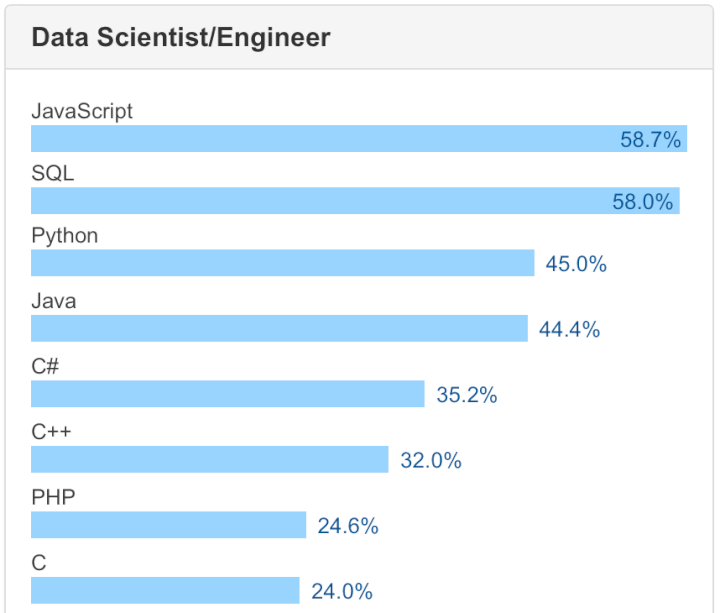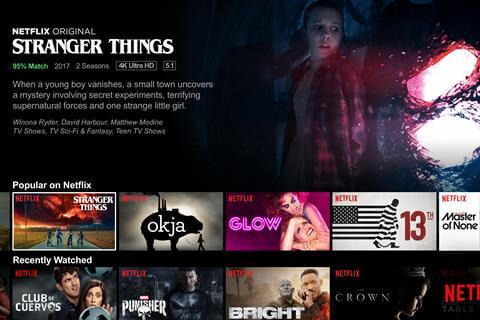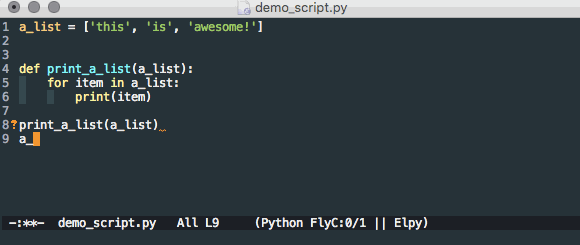Python is a high-level programming language first released in 1991 by Guido van Rossum, with a broad range of applications including data science, machine learning and AI, software development, and even games.
With its focus on the developer experience and code readability, many people find it very productive to work in Python, as they can focus on their application's core functionality, rather than lower-level programming tasks.
Python is one of the fastest-growing and most popular programming languages. A 2019 Stack Overflow survey found that Python is the fourth most popular language overall, and the number two most loved language, illustrating how programmers can't get enough of Python these days.
In this article, we will answer the frequently asked question "What is Python used for?", and shed some light on the many applications of this sought-after language.
If you haven't already, check out our Introduction to Python and Python for Data Analysis courses, but for now, let's dive into some real-world uses of this Monty Python-inspired language to find out more!

Interested in web development?
Learn all about it in our comprehensive (and free) ebook!
Data science
Data science describes the use of tools like programming, processes, and algorithms to extract useful information and insights from data. Quite often, these are vast data sets, which can't be easily analyzed without those tools. According to a Stack Overflow survey in 2017, Python is the third most used programming language for data science.

People often describe Python as "batteries-included," meaning a lot of useful tools that people might want to use are included and built-in when you install Python on your computer. This is especially true for data science, as it comes with a lot of built-in libraries you can use for that purpose.
However, if those libraries don't quite fit what you're doing, there are a tonne of free and open-source libraries you can utilize easily. This is due to the built-in package management tool "pip" (which stands for "Pip Installs Packages," one of the beloved recursive acronyms). Some of the more popular libraries include NumPy, Pandas, SciPy, and matplotlib. Many of these have been around for a long time, meaning they're very stable and battle-tested.
Universities like MIT are known to use Python for exciting studies. Researchers at MIT have identified a new antibiotic compound using a machine learning algorithm. They used open-source software RDKit, a collection of software written partly in Python.
If you're interested in learning more about data science using Python, make sure you check out our Python for Data Analysis course!
Machine learning and AI
Python is also used for a subset of artificial intelligence (AI) – machine learning, which describes the use of a certain type of algorithm to analyze data sets and make predictions on similar events. This can be part of data science, though it can also be used for other purposes, from image recognition to detecting fraudulent transactions.
If you've ever shopped at Amazon, you will have seen their use of Python for machine learning in action. To show you useful recommendations based on your purchasing behavior, they use Python to analyze the vast amounts of data they have on you (scary, but cool), and Python works well with "Big Data."
Additionally, developers at Netflix have said they use Python extensively when training their machine learning models for things like recommendations and showing different artwork to different users.

Web development
When you start talking about websites, APIs, and web applications, this is the realm of web development - it involves all software that's accessible through the internet.
You can think of websites as having a "front end" and "back end" component. The front end is anything you see in your browser (e.g., Google Chrome, Firefox, or Safari). It includes the visual aspects on the page, like layout, fonts, and colors, as well as some interactivity in certain web applications like interacting with emails in Gmail or finding a GIF for your tweet on Twitter. All of this code runs on your computer when you visit these websites.
The back end is reserved for more of the core functionality and business logic of web applications. This includes authentication (verifying that your login details are correct), actually delivering the email you wrote to the other person, and loading the list of tweets to give to the front end to nicely laid out on the page, etc. All of this happens on a server somewhere in the world, rather than on the computer you're on when visiting those websites.
And this is where Python comes in: the back end. Because of its focus on writing expressive code, it makes it easy to focus on your application's core business logic. The two main libraries that are used for web development in Python are Django and Flask.

The great thing about using Python for your web server is that you can leverage the other tools we've mentioned above. This makes it easy to include machine learning, AI, or data processing in your web-based projects.
You may be wondering how Python stacks up to other languages when it comes to the big players. The company that's become a verb, Google, is widely known to use Python for a lot of their projects from very early on, even rewriting applications originally written in other languages because Python is easier to maintain and deploy. The creator of Python, Guido van Rossum, also worked at Google for several years.
Python has also been used in various capacities by the likes of Netflix, Spotify, Reddit, and Instagram - no small feat! Python is well-known for its extensive use in web development, alongside languages like C# which offer robust solutions for backend scripting and automation. Web development professionals or enthusiasts looking to expand their toolkit might benefit from exploring web scraping with other languages. A comprehensive guide on web scraping in C# provides a deep dive into the intricacies of using C# to gather data from the internet efficiently.
Games and desktop applications
Don't get me wrong, you probably won't see Python used for big-budget games that require high performance, but it's still great when you're just starting to learn how to make games. It's great for creating prototypes - with PyGame, for example - and it's a useful language to know as a tool you can use to automate tasks related to game development.
Using libraries like PyQT and Tkinter, you can create desktop applications with graphical interfaces that work on multiple platforms, e.g., Linux, Windows, and Mac. This might save you a lot of time if you would otherwise have to create separate apps for each platform.
Scripting and other applications
Python is a scripting language, which means it's unlike languages such as C#, C++, or Go, where programs need to be compiled before you can execute them. With Python, you can write a script and execute it straight away. This makes writing code in Python quite flexible, as you can write a little bit of code, then run it and quickly make adjustments or extend it, then run it again.

This kind of approach to coding is very suitable for automating simple tasks on your computer, such as moving lots of files around, monitoring websites, or running a simple web server.
The Linux community is also a big user of Python - both of which are open source projects, meaning anyone can see the source code and contribute changes themselves. In a blog post on their website, Red Hat (one of the many distributions of Linux around) outlines how Python is used in many widely used Linux programs, such as Firewalld, yum, and Ansible.
Integrations
As you know by now, Python is pretty great. However, like a lot of other high-level programming languages, it has some downsides. For example, compared to lower-level languages like C and C++, Python is quite slow. Now, with powerful computers everywhere, this isn't so much of an issue, but sometimes you do need to get the most performance as possible.
Luckily, that doesn't mean that Python is entirely off the table! It's relatively easy to integrate Python with code written in other languages, like C or C++. This means that you can keep the bulk of your application written in Python for that great developer experience and ease of maintenance while having the most power-hungry bits of your application written in something more performant. This allows different teams in your organization to focus on different parts of your application, e.g., data scientists working with programmers.
The same goes for using libraries that you want to use that are not available in Python, as well as working with the most popular databases out there.
That's all, folks
Seeing as you made it to the end of this article, hopefully, it's clear that Python can be used for a significant number of things, and can accomplish almost any programming task, and even when it's not, there might still be a way to use it! Either way, it's a great language to have in your programming tool belt.
If you're still pretty new to the language or even want to dip your toes into programming as a whole, why not start learning Python at GoSkills? Take our Intro to Python and Python for Data Analysis courses for a spin today.
We also have a number of development courses for other languages, like JavaScript, HTML & CSS, Ruby, and more.
Happy coding and happy learning, everyone!
Get started with a 7 day free trial of all GoSkills award-winning courses today.
Learn in-demand skills
Take your career to the next level with GoSkills coding courses
Start free trial



